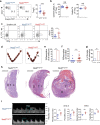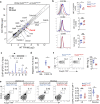Histone methyltransferase Nsd2 ensures maternal-fetal immune tolerance by promoting regulatory T-cell recruitment
- PMID: 35322173
- PMCID: PMC9061842
- DOI: 10.1038/s41423-022-00849-2
Histone methyltransferase Nsd2 ensures maternal-fetal immune tolerance by promoting regulatory T-cell recruitment
Abstract
Regulatory T cells (Tregs) are fundamentally important for maintaining systemic immune homeostasis and are also required for immune tolerance at the maternal-fetal interface during pregnancy. Recent studies have suggested that epigenetic regulation is critically involved in Treg development and function. However, the role of H3K36me has not yet been investigated. Here, we found that the H3K36me2 methyltransferase Nsd2 was highly expressed in Tregs. Although loss of Nsd2 did not impair systemic Treg development or function, the level of Tregs at the maternal-fetal interface was significantly decreased in pregnant Nsd2 conditional knockout mice. Consequently, maternal-fetal immune tolerance was disrupted in the absence of Nsd2 in Tregs, and the pregnant mice showed severe fetal loss. Mechanistically, Nsd2 was found to upregulate CXCR4 expression via H3K36me2 modification to promote Treg cell recruitment into the decidua and suppress the anti-fetal immune response. Overall, our data identified Nsd2 as a critical epigenetic regulator of Treg recruitment for maternal-fetal tolerance.
Keywords: Cell migration; Immune tolerance; Regulatory T cell.
© 2022. The Author(s), under exclusive licence to CSI and USTC.
Conflict of interest statement
The authors declare no competing interests.
Figures






Similar articles
-
A PWWP Domain of Histone-Lysine N-Methyltransferase NSD2 Binds to Dimethylated Lys-36 of Histone H3 and Regulates NSD2 Function at Chromatin.J Biol Chem. 2016 Apr 15;291(16):8465-74. doi: 10.1074/jbc.M116.720748. Epub 2016 Feb 24. J Biol Chem. 2016. PMID: 26912663 Free PMC article.
-
Histone methyltransferase Nsd2 is required for follicular helper T cell differentiation.J Exp Med. 2020 Jan 6;217(1):e20190832. doi: 10.1084/jem.20190832. J Exp Med. 2020. PMID: 31636135 Free PMC article.
-
The role of thymus- and extrathymus-derived regulatory T cells in maternal-fetal tolerance.Front Immunol. 2023 Feb 2;14:1109352. doi: 10.3389/fimmu.2023.1109352. eCollection 2023. Front Immunol. 2023. PMID: 36817424 Free PMC article.
-
Potentiating maternal immune tolerance in pregnancy: a new challenging role for regulatory T cells.Placenta. 2014 Apr;35(4):241-8. doi: 10.1016/j.placenta.2014.02.004. Epub 2014 Feb 14. Placenta. 2014. PMID: 24581729 Review.
-
Exploring the Origin and Antigenic Specificity of Maternal Regulatory T Cells in Pregnancy.Front Immunol. 2020 Jun 25;11:1302. doi: 10.3389/fimmu.2020.01302. eCollection 2020. Front Immunol. 2020. PMID: 32670288 Free PMC article. Review.
Cited by
-
Epigenetics of maternal-fetal interface immune microenvironment and placental related pregnancy complications.Front Immunol. 2025 Apr 3;16:1549839. doi: 10.3389/fimmu.2025.1549839. eCollection 2025. Front Immunol. 2025. PMID: 40248704 Free PMC article. Review.
-
Epigenetic regulation of human FOXP3+ Tregs: from homeostasis maintenance to pathogen defense.Front Immunol. 2024 Jul 31;15:1444533. doi: 10.3389/fimmu.2024.1444533. eCollection 2024. Front Immunol. 2024. PMID: 39144146 Free PMC article. Review.
-
miR-126-5p protects from URSA via inhibiting Caspase-1-dependent pyroptosis of trophoblast cells.Cell Mol Life Sci. 2025 May 15;82(1):204. doi: 10.1007/s00018-025-05713-w. Cell Mol Life Sci. 2025. PMID: 40372489 Free PMC article.
-
Pregnancy-acquired memory CD4+ regulatory T cells improve pregnancy outcome in mice.Nat Commun. 2025 Jul 15;16(1):6522. doi: 10.1038/s41467-025-61572-w. Nat Commun. 2025. PMID: 40664658 Free PMC article.
-
Development of a humanized mouse model with functional human materno-fetal interface immunity.JCI Insight. 2024 Oct 22;9(20):e176527. doi: 10.1172/jci.insight.176527. JCI Insight. 2024. PMID: 39435662 Free PMC article.
References
Publication types
MeSH terms
Substances
LinkOut - more resources
Full Text Sources
Molecular Biology Databases

